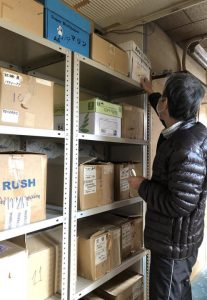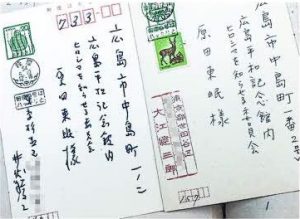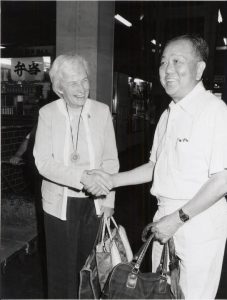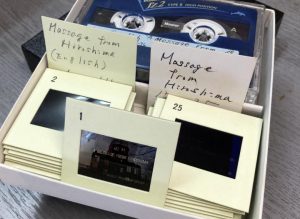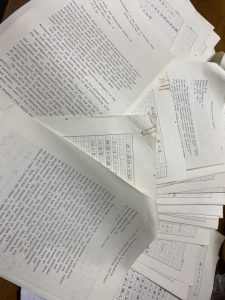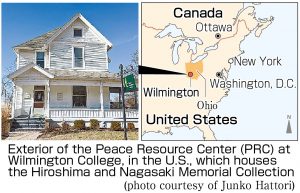Existing documents reveal grassroots enthusiasm of Hiroshima Appeal Committee 50 years ago
Jul. 24, 2023
by Hiromi Morita, Staff Writer
Half a century ago, a time when overseas travel and communication were not as easy as they are today, there was a group in Hiroshima that sent A-bombing documents and materials to people in the United States, a nuclear superpower, to communicate the devastating consequences to humans of nuclear weapons. The group was the Hiroshima Appeal Committee (HAC). For 15 years after its establishment in 1973, the group engaged in worldwide grassroots activities. Hints of their long-forgotten work can be seen in materials that remain today at the World Friendship Center (WFC), a non-profit organization based in Hiroshima’s Nishi Ward that took over HAC activities after its dissolution, and in those held by people that had been involved at the time.
On October 23, 1973, Barbara Reynolds, an American peace activist and founder of the WFC, returned to Hiroshima for the first time in a while. The purpose of her visit was to call for cooperation with respect to the Hiroshima and Nagasaki Memorial Collection, a project she promoted and that was underway at Wilmington College in the U.S. state of Ohio. With her, she carried a letter from Robert Henshaw, president of the college at the time, addressed to Hiroshima Mayor Setsuo Yamada. Ms. Reynold’s friends, including Tomin Harada, the first chairperson of the WFC, met Ms. Reynolds at the Hiroshima Station, as the Chugoku Shimbun reported in its newspaper dated October 24.
Mr. Harada apparently responded to her request immediately. A document Mr. Harada used to call on peace groups and academics for their support remains today at the WFC. “Hiroshima will form a committee organization at this opportunity to call on the United States and other countries for cooperation to actively engage in collecting documents,” reads the statement.
The HAC, founded in November 1973, placed its office within the Hiroshima Peace Culture Foundation, and Mr. Harada was appointed its chairperson. HAC members included Reverend Kiyoshi Tanimoto, the poet Miyao Ohara, Hiroshima University professor Seiji Imabori, and Kaoru Ogura, who served as chief of the Hiroshima City government’s Liaison Section. All of them were prominent figures in the A-bombed city at the time.
Large volumes of materials have been found at the WFC and related organizations, including memos about the library concept translated by Ms. Reynolds, correspondence between Ms. Reynolds in the United States and HAC members, as well as project plans and ledgers. WFC members are currently at work sorting through the materials. Handwritten records detail the enthusiasm of citizens who channeled their talents to convey the reality of the A-bombed city of Hiroshima.
The HAC’s work began with the selection and sending out of literature related to the atomic bombing. According to the 20 Years of History, a publication issued by the Hiroshima Peace Culture Foundation, and other sources, 520 items were sent to the library from the time of the HAC’s establishment. Of that total, summaries and their English translations attached to at least 109 of the materials remain today. The translations were carried out by WFC members and citizens who had signed on to the aims of the project.
Sent to the United States were not only items of a material nature. In 1982, the HAS dispatched Miyoko Matsubara, an A-bomb survivor who oversaw administrative affairs for the organization, to work on the U.S. Peace Caravan initiative. Ms. Matsubara traveled throughout the United States with Ms. Reynolds and others, conveying the reality of the atomic bombing through exhibits of drawings done by A-bomb survivors and her own testimonies of her experiences in the atomic bombing.
The organization was also active in Japan. To prevent memories of the atomic bombing from fading, the group summarized A-bombing literature and edited and published two books, including one titled Hiroshima wo Kataru Jussatsu no Hon (in English, ‘10 publications that tell the story of the A-bombed Hiroshima’). Replies from authors Masuji Ibuse and Kenzaburo Oe, from whom permission for inclusion of their works for publication was requested, also remain.
The organization also appears to have formulated three kinds of slides conveying information about the atomic bombing, translated them into other languages, and sold or lent them out. From the remaining application forms for the slides can be discerned just how far the materials spread around the world.
Nevertheless, the HAC was dissolved in 1988 without finding a successor for Mr. Harada, who had grown elderly and become ill. Most of the people involved in the group’s activities have since died. Shizuo Tachibana, chair of the WFC, said, “By looking at the documents that had been stored away, the members’ efforts to convey the reality of the atomic bombing under the slogan ‘All Hiroshima’ can be clearly understood. Now is the time to recall their precious enthusiasm.”
Keywords
Barbara Reynolds
Barbara Reynolds lived in Hiroshima starting in 1951 with her husband, who worked as a researcher at the Atomic Bomb Casualty Commission (ABCC; present-day Radiation Effects Research Foundation, or RERF). Disheartened by the destruction caused by the atomic bombings, she devoted herself to anti-nuclear and world peace activities. In 1962 and 1964, she spent her own money to visit nuclear weapons states and other countries in the West together with A-bomb survivors on what was called the World Peace Pilgrimage, conveying the reality of the destruction caused in the atomic bombing. In 1965, she founded the World Friendship Center (WFC) in Hiroshima as a base for peace exchange. Even after returning to the United States in 1965, she stood with A-bomb survivors and continued her peace activities. She died in 1990 at the age of 74.
Tomin Harada
Tomin Harada returned to Hiroshima at the end of the war as an Army physician. Starting in 1946, he devoted himself to providing medical care for A-bomb survivors. In 1955, he accompanied women A-bomb survivors who had suffered severe burns on their faces and bodies on a journey to the United States for medical treatment and worked to communicate the tragic consequences of the atomic bombing to the world. He was appointed as the first chairperson of the WFC in 1965 and died in 1999 at the age of 87.
(Originally published on July 24, 2023)
Half a century ago, a time when overseas travel and communication were not as easy as they are today, there was a group in Hiroshima that sent A-bombing documents and materials to people in the United States, a nuclear superpower, to communicate the devastating consequences to humans of nuclear weapons. The group was the Hiroshima Appeal Committee (HAC). For 15 years after its establishment in 1973, the group engaged in worldwide grassroots activities. Hints of their long-forgotten work can be seen in materials that remain today at the World Friendship Center (WFC), a non-profit organization based in Hiroshima’s Nishi Ward that took over HAC activities after its dissolution, and in those held by people that had been involved at the time.
“All Hiroshima” members active in peace groups and academia
Activities and literature about A-bombing communicated to US citizens
On October 23, 1973, Barbara Reynolds, an American peace activist and founder of the WFC, returned to Hiroshima for the first time in a while. The purpose of her visit was to call for cooperation with respect to the Hiroshima and Nagasaki Memorial Collection, a project she promoted and that was underway at Wilmington College in the U.S. state of Ohio. With her, she carried a letter from Robert Henshaw, president of the college at the time, addressed to Hiroshima Mayor Setsuo Yamada. Ms. Reynold’s friends, including Tomin Harada, the first chairperson of the WFC, met Ms. Reynolds at the Hiroshima Station, as the Chugoku Shimbun reported in its newspaper dated October 24.
Mr. Harada apparently responded to her request immediately. A document Mr. Harada used to call on peace groups and academics for their support remains today at the WFC. “Hiroshima will form a committee organization at this opportunity to call on the United States and other countries for cooperation to actively engage in collecting documents,” reads the statement.
The HAC, founded in November 1973, placed its office within the Hiroshima Peace Culture Foundation, and Mr. Harada was appointed its chairperson. HAC members included Reverend Kiyoshi Tanimoto, the poet Miyao Ohara, Hiroshima University professor Seiji Imabori, and Kaoru Ogura, who served as chief of the Hiroshima City government’s Liaison Section. All of them were prominent figures in the A-bombed city at the time.
Large volumes of materials have been found at the WFC and related organizations, including memos about the library concept translated by Ms. Reynolds, correspondence between Ms. Reynolds in the United States and HAC members, as well as project plans and ledgers. WFC members are currently at work sorting through the materials. Handwritten records detail the enthusiasm of citizens who channeled their talents to convey the reality of the A-bombed city of Hiroshima.
The HAC’s work began with the selection and sending out of literature related to the atomic bombing. According to the 20 Years of History, a publication issued by the Hiroshima Peace Culture Foundation, and other sources, 520 items were sent to the library from the time of the HAC’s establishment. Of that total, summaries and their English translations attached to at least 109 of the materials remain today. The translations were carried out by WFC members and citizens who had signed on to the aims of the project.
Sent to the United States were not only items of a material nature. In 1982, the HAS dispatched Miyoko Matsubara, an A-bomb survivor who oversaw administrative affairs for the organization, to work on the U.S. Peace Caravan initiative. Ms. Matsubara traveled throughout the United States with Ms. Reynolds and others, conveying the reality of the atomic bombing through exhibits of drawings done by A-bomb survivors and her own testimonies of her experiences in the atomic bombing.
The organization was also active in Japan. To prevent memories of the atomic bombing from fading, the group summarized A-bombing literature and edited and published two books, including one titled Hiroshima wo Kataru Jussatsu no Hon (in English, ‘10 publications that tell the story of the A-bombed Hiroshima’). Replies from authors Masuji Ibuse and Kenzaburo Oe, from whom permission for inclusion of their works for publication was requested, also remain.
The organization also appears to have formulated three kinds of slides conveying information about the atomic bombing, translated them into other languages, and sold or lent them out. From the remaining application forms for the slides can be discerned just how far the materials spread around the world.
Nevertheless, the HAC was dissolved in 1988 without finding a successor for Mr. Harada, who had grown elderly and become ill. Most of the people involved in the group’s activities have since died. Shizuo Tachibana, chair of the WFC, said, “By looking at the documents that had been stored away, the members’ efforts to convey the reality of the atomic bombing under the slogan ‘All Hiroshima’ can be clearly understood. Now is the time to recall their precious enthusiasm.”
Keywords
Barbara Reynolds
Barbara Reynolds lived in Hiroshima starting in 1951 with her husband, who worked as a researcher at the Atomic Bomb Casualty Commission (ABCC; present-day Radiation Effects Research Foundation, or RERF). Disheartened by the destruction caused by the atomic bombings, she devoted herself to anti-nuclear and world peace activities. In 1962 and 1964, she spent her own money to visit nuclear weapons states and other countries in the West together with A-bomb survivors on what was called the World Peace Pilgrimage, conveying the reality of the destruction caused in the atomic bombing. In 1965, she founded the World Friendship Center (WFC) in Hiroshima as a base for peace exchange. Even after returning to the United States in 1965, she stood with A-bomb survivors and continued her peace activities. She died in 1990 at the age of 74.
Tomin Harada
Tomin Harada returned to Hiroshima at the end of the war as an Army physician. Starting in 1946, he devoted himself to providing medical care for A-bomb survivors. In 1955, he accompanied women A-bomb survivors who had suffered severe burns on their faces and bodies on a journey to the United States for medical treatment and worked to communicate the tragic consequences of the atomic bombing to the world. He was appointed as the first chairperson of the WFC in 1965 and died in 1999 at the age of 87.
(Originally published on July 24, 2023)

